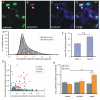Calretinin and calbindin distribution patterns specify subpopulations of type I and type II spiral ganglion neurons in postnatal murine cochlea
- PMID: 24414968
- PMCID: PMC3997597
- DOI: 10.1002/cne.23535
Calretinin and calbindin distribution patterns specify subpopulations of type I and type II spiral ganglion neurons in postnatal murine cochlea
Abstract
As the first neural element in the auditory pathway, neurons in the spiral ganglion shape the initial coding of sound stimuli for subsequent processing. Within the ganglion, type I and type II neurons form divergent and convergent innervation patterns, respectively, with their hair cell sensory receptors, indicating that very different information is gathered and conveyed. Layered onto these basic innervation patterns are structural and electrophysiological features that provide additional levels of processing multifaceted sound stimuli. To understand the nature of this additional complexity of signal coding, we characterized the distribution of calretinin and calbindin, two regulators of intracellular calcium that serve as markers for neuronal subpopulations. We showed in acute preparations and in vitro that calretinin and calbindin staining levels were heterogeneous. Immunocytochemical analysis of colocalization further showed that high levels of staining for the two molecules rarely overlapped. Although varied amounts of calbindin and calretinin were found within each tonotopic location and neuronal type, some distinct subdistributions were noted. For example, calretinin levels were highest in neurons innervating the midcochlea region, whereas calbindin levels were similar across the entire ganglion. Furthermore, we noted that apical type II neurons, identified by antiperipherin labeling, had significantly lower levels of calretinin and higher levels of calbindin. We also established that the endogenous firing feature of onset tau of the subthreshold response showed a pattern related to quantified calretinin and calbindin staining levels. Taken together, our results suggest an additional dimension of complexity within the spiral ganglion beyond that currently categorized.
Keywords: calbindin; calretinin; spiral ganglion.
Copyright © 2014 Wiley Periodicals, Inc.
Figures










Similar articles
-
Regional specification of threshold sensitivity and response time in CBA/CaJ mouse spiral ganglion neurons.J Neurophysiol. 2007 Oct;98(4):2215-22. doi: 10.1152/jn.00284.2007. Epub 2007 Aug 22. J Neurophysiol. 2007. PMID: 17715200
-
Firing features and potassium channel content of murine spiral ganglion neurons vary with cochlear location.J Comp Neurol. 2002 Jun 10;447(4):331-50. doi: 10.1002/cne.10244. J Comp Neurol. 2002. PMID: 11992520
-
Firing patterns of type II spiral ganglion neurons in vitro.J Neurosci. 2004 Jan 21;24(3):733-42. doi: 10.1523/JNEUROSCI.3923-03.2004. J Neurosci. 2004. PMID: 14736859 Free PMC article.
-
Cellular distribution of the calcium-binding proteins parvalbumin, calbindin, and calretinin in the neocortex of mammals: phylogenetic and developmental patterns.J Chem Neuroanat. 1999 Feb;16(2):77-116. doi: 10.1016/s0891-0618(98)00065-9. J Chem Neuroanat. 1999. PMID: 10223310 Review.
-
Complex primary afferents: What the distribution of electrophysiologically-relevant phenotypes within the spiral ganglion tells us about peripheral neural coding.Hear Res. 2011 Jun;276(1-2):34-43. doi: 10.1016/j.heares.2011.01.014. Epub 2011 Jan 27. Hear Res. 2011. PMID: 21276843 Free PMC article. Review.
Cited by
-
Nicotinic acetylcholine receptors regulate vestibular afferent gain and activation timing.J Comp Neurol. 2017 Apr 1;525(5):1216-1233. doi: 10.1002/cne.24131. Epub 2016 Nov 21. J Comp Neurol. 2017. PMID: 27718229 Free PMC article.
-
Spatial Gradients in the Size of Inner Hair Cell Ribbons Emerge Before the Onset of Hearing in Rats.J Assoc Res Otolaryngol. 2017 Jun;18(3):399-413. doi: 10.1007/s10162-017-0620-1. Epub 2017 Mar 30. J Assoc Res Otolaryngol. 2017. PMID: 28361374 Free PMC article.
-
Analog transmission of action potential fine structure in spiral ganglion axons.J Neurophysiol. 2021 Sep 1;126(3):888-905. doi: 10.1152/jn.00237.2021. Epub 2021 Aug 4. J Neurophysiol. 2021. PMID: 34346782 Free PMC article.
-
Neuroanatomical and neurochemical atlas of the spiny mouse (Acomys cahirinus) spinal cord.Brain Struct Funct. 2025 Jul 28;230(7):124. doi: 10.1007/s00429-025-02982-w. Brain Struct Funct. 2025. PMID: 40719809
-
The hair cell analysis toolbox is a precise and fully automated pipeline for whole cochlea hair cell quantification.PLoS Biol. 2023 Mar 22;21(3):e3002041. doi: 10.1371/journal.pbio.3002041. eCollection 2023 Mar. PLoS Biol. 2023. PMID: 36947567 Free PMC article.
References
-
- Adamson CL, Reid MA, Mo Z-L, Bowne-English J, Davis RL. Firing features and potassium channel content of murine spiral ganglion neurons vary with cochlear location. J Comp Neurol. 2002;447:331–350. - PubMed
-
- Baizer JS, Broussard DM. Expression of calcium-binding proteins and nNOS in the human vestibular and precerebellar brainstem. J Comp Neurol. 2010;518:872–895. - PubMed
-
- Bizley JK, Walker KMM. Sensitivity and selectivity of neurons in auditory cortex to the pitch, timbre, and location of sounds. Neuroscientist. 2010;16:453–469. - PubMed
Publication types
MeSH terms
Substances
Grants and funding
LinkOut - more resources
Full Text Sources
Other Literature Sources
Research Materials

